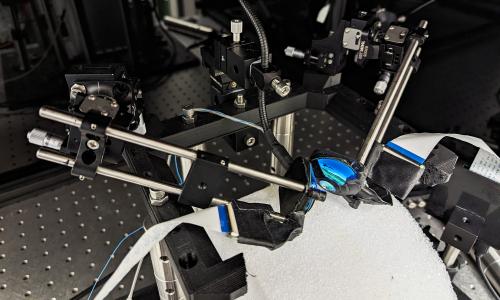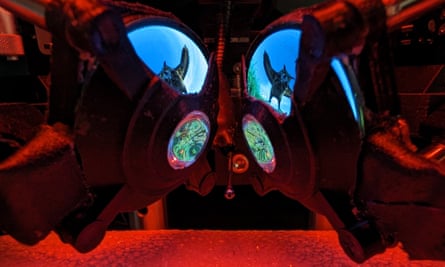Whether it’s exploring distant galaxies or racing through a fantasy world, virtual reality has immersed people in extraordinary places. Now, it seems, mice will be able to join us.
Researchers have developed a pair of virtual reality “goggles” that can immerse the rodents in various scenarios, from navigating mazes to experiencing the threat of a predator.
While VR has been used in mouse experiments for years, the researchers say it typically involved placing the animals on a treadmill in front of a large screen displaying a digital scene, with their heads fixed in place to study their brains .
Prof Daniel Dombeck, a co-author of the study at Northwestern University, in Illinois, said this had drawbacks as the mice could still see the static laboratory environment and equipment while moving through the virtual world by walking on the treadmill. .
“We think [this] reduce their immersion in the virtual world,” he said. “There is also no depth information provided by large screens; the mice only see the same flat scene as we do when we watch TV.”
By contrast, the new setup, revealed in the journal Neuron, involves a pair of lenses and screens mounted on stands on either side of a mouse’s head, giving each eye a 180-degree field of view. Again, the mouse’s head is fixed in place and it can navigate the virtual environment using the treadmill.

“Our prototype glasses system described in this paper is a bit too big to be carried around by mice, but we plan to make smaller versions in the future that mice can carry around like a headset,” said Dombeck.
The team says the new approach not only allows mice to see the virtual environment in 3D, eliminating visual cues from the lab, but provides a way to present virtual images from above – for example, of a soaring falcon .

“This stimulation in real environments causes mice to freeze or flee, responses they have to survive a raptor attack in the wild,” Dombeck said.
The team’s experiments show mice react in the same way in the VR glasses system. When the mice froze, activity of neurons in their brains involved in navigation suggested that they were in a different place than where they actually were.
“It was as if they were thinking about where they would rather be — a safe, covered place ahead,” Dombeck said, adding that such results could help explain how imagination arises in the brain.
The team is also working to identify neurons involved in the formation of memories when mice navigate a maze, as well as which connections between them are modified to form memories, and how.
“Answering these questions will help us understand how our brain knows where we are in the world around us, how we form memories of those experiences, and ultimately,” Dombeck said, “how those memories are degraded in neurodegenerative diseases.”



